Tornado Impacts to Solar Project
August 28, 2015 - Chuckwalla Valley, Riverside County CA - As strange as it may seem in the California Desert, and more likely in Oklahoma, a tornado that had ripped through the Desert Sunlight Solar Farm last April caused extensive damage.
According to the Bureau of Land Management (personal communication), there were 154,843 modules damaged. All debris located outside of the project fence has been removed with no residual effect. All major broken glass has been removed from within the fence and plant. Glass and damaged structure removal has been manual with materials moved to staging areas via carts, trucks and trailers.
Broken glass is being shipped using 20 yard bins to Clean Harbors landfill in Button Willow CA. Recycled modules are being shipped via boxes to Veolia ES Technical Solutions in Phoenix AZ. There is no indication of soil contamination. This clean-up effort is progressing.
Desert Sunlight Solar Project Damaged by Tornado
April 23, 2015 - Desert Center CA - The National Weather Service reported that a tornado touched down Tuesday afternoon. Wednesday the Weather Service gave the tornado a rating of "E-F-0." The tornado formed just east of Kaiser Road and damaged the Desert Sunlight Solar Project, breaking some photovoltaic panels. We received photos of the damage from viewer Jim Kreizinger. The National Weather Service says they plan to tour the solar plant next week and get a first hand look at the damaged solar panels.
http://www.liveleak.com/view?i=a44_1429678817
http://www.kesq.com/news/solar-farm-damaged-by-desert-center-tornado/32517226
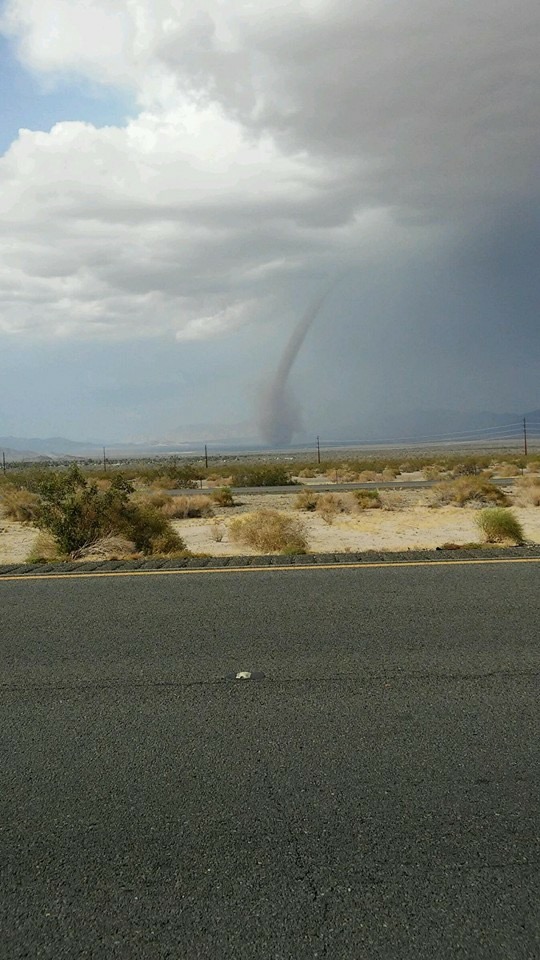
^Tornado in Chuckwalla Valley, Riverside County CA. Photo: Melissa Cruisinberry
Solar Scorecard Released by Silicon Valley Toxics Coalition
Novemebr 23, 2014 - On November 11 the Silicon Valley Toxics Coalition (SVTC) today released its fifth annual Solar Scorecard, ranking the world’s largest solar companies on their efforts to improve their environmental impacts.
From their website: for over three decades, SVTC has been a leader in encouraging electronics manufacturers to take lifecycle responsibility for their products. This includes protecting workers from toxic exposure and preventing hazardous e-waste dumping in developing countries like India, Ghana, and China that lack the proper infrastructure to protect workers and the environment. SVTC also seeks to stop the practice of sending e-waste to U.S. prisons for dismantling, which results in toxic exposure to inmates.
The Scorecard is a resource for consumers, institutional purchasers, investors, installers, and anyone who wants to purchase photovoltaic (PV) modules from responsible product stewards. The Scorecard reveals how companies perform on SVTC’s sustainability and social justice benchmarks to ensure that the PV manufacturers protect workers, communities, and the environment. The PV industry’s continued growth makes it critical that action be taken now to reduce the use of toxic chemicals, develop responsible recycling systems, and protect workers throughout global PV supply chains. Many PV companies want to produce truly clean and green energy systems and are taking steps to implement more sustainable practices. We note First Solar gets a zero for biodoversity suatainability.
Desert Sunlight Solar Farm Project Requesting MORE Groundwater Pumped During Record Drought in California
August 26, 2014 - Riverside County, CA - During California's worst drought in recorded history, First Solar's Desert Sunlight Solar Farm Project is requesting a 50 acre-feet increase in the amount of groundwater the project is allowed to pump from the desert aquifer. The Bureau of Land Management (BLM) is preparing an Environmental Assessment to evaluate the effects of this action. Remediation efforts from recent heavy summer rains are part of the need.
This is the letter sent to Basin & Range Watch by BLM:
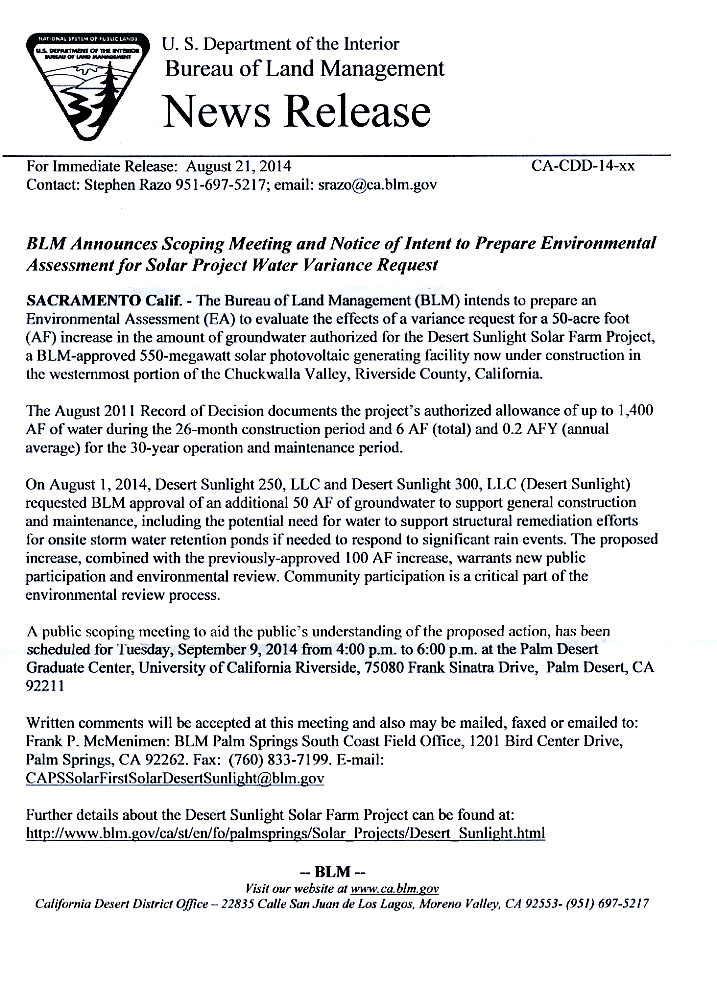
Flood Damage Update
September 17, 2013 - We received this report from the Bureau of Land Management:
Desert Sunlight Solar Project
Between August 22nd and August 25th, numerous small rain events occurred in the western Chuckwalla Valley. On August 25th, a storm cell produced significant rainfall on the Eagle Mountains, focused roughly due west of the Desert Sunlight Solar Project. Significant runoff resulted, filling washes, flooding roads, and inundating the project site. Associated wind damage contributed to the overall impacts by knocking over trailers and downing power lines including one line that laid across the main project access road for some time.
Surface water flows passed through the project site in an easterly direction before emptying into Pinto Wash. These flows resulted in damage to the security and desert tortoise fences and the retention ponds along the northwest side of the project. Some damage also occurred to the desert tortoise fencing on the southern edge of the project.
Sediment ponds were also significantly impacted; those along the southern edge primarily experienced scour and gullying along their flanks, while those along the western edge were partially to completely filled with sediment.
Overall, the engineered “sheet flow” grading design at Desert Sunlight appears to have been effective in handling runoff from this storm. Recommended improvements under consideration include increased armoring of retention basins at locations where washout damage occurred. In addition, retention basins along the western side of the project could be enlarged to accommodate more water flow.
Genesis Solar Project
Between August 22nd and August 25th, numerous rain events occurred in the Chuckwalla Valley. These events led to onsite damage at the Genesis Solar Project including standing water within the site and access road areas; damage to perimeter security and desert tortoise fencing; breaching of several levees; improper functioning of detention basins resulting in concentrated water flows and erosion; along with offsite flows in several other areas where the storm water drainage system was inadequate to channel runoff as designed.
An assessment of these issues has taken place and improvements are proposed to eliminate any further problems. These include installation drain outlet piping, improving up to 400 feet of level weir to produce sheet flow in lieu of the present concentrated flows and resultant down-cutting, and installation of erosion resistant materials where breaching had occurred.
In addition, the drain apron at the end of Channel A, located on the western side of the project, functioned in a manner that allowed for concentrated water flows to enter and flow through a recorded archaeological site. This drain apron, however, was designed to discharge storm water at lower velocity sheet flows that would approximate natural storm runoff. Redesign measures are being assessed to insure that the archaeological site is protected.
We continue to work with these projects on their storm water drainage systems in order to make them more effecient and reduce the potential for additional unanticipated off-site damage.
Please feel free to contact us again on these matters.
--
John R. Kalish, Acting Dep. District Manager, Resources
Bureau of Land Management
California Desert District
22836 Calle San Juan de Los Lagos
Moreno Valley, CA 92553-9046
951-697-5252
Storm Flood Damage to Desert Sunlight Solar Farm
August 25, 2013 - Desert Center, CA. Yesterday a massive storm hit part of the Chuckwalla Valley, a rainy cell from the Tropical Storm Evo activity along the Pacific coast of Mexico streaming northwards. The photovoltaic solar project was flooded. Desert flatlands turned into a river of churning brown water according to eye-witnesses, as more than an inch of rain fell on the valley. Part of a tortoise exclusion fence was down, washed away by the flash flood. The security fence went down in places and air conditioners for the inverter boxes are smashed into each orher. Twenty power poles are down on Kaiser Road. First Solar workers could not leave until after 10 PM last night because the downed powerlines energized their security fence and nobody could leave until Edison removed the poles. This was one of the worst storms in decades here.
See aerial photos of the solar project at http://guntherportfolio.com/2013/08/first-desert-sunlight-solar/. We will be posting more recent photos of any flood damage as we get them.
Endangered Yuma Clapper Rail Killed at Solar Project
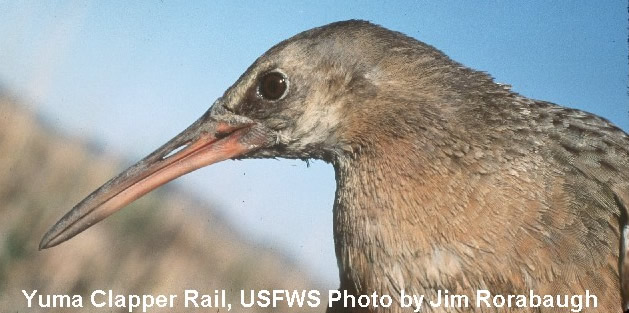
July 1, 2013 - The Bureau of Land Management told us that a Clapper rail kill that occurred on the Desert Sunlight Solar Project on May 8, 2013. US Fish and Wildlife Service confirmed to us that a Yuma clapper rail (Rallus longirostris yumanensis) was found dead at the Desert Sunlight Project by project personnel. Other water birds -- grebes -- have also been found dead on the project. USFWS did a necropsy in an Oregon lab to determine the subspecies of the rail.
The flyway from the Colorado River to the Salton Sea now has a project that looks very much like a lake, but is composed of solar panels. This lake effect caused by the glass of photovoltaic panel arrays has been mentioned in comments numerous times by Basin & Range Watch and others.
This subspecies is listed as federally endangered under the Endangered Species Act. Coastal subspecies live along the Pacific, Atlantic, and Gulf coast marshes.
These rails prefer freshwater marshes, and have populations around the Salton Sea of California, Colorado River, Gila River, and up to the Virgin River and Muddy River in the Nevada and Utah regions. The bird may have been flying between marsh areas when it mistakenly tried to land on the glassy surface of the solar field, thinking it was a lake. It is partially migratory and many winter in marshes of the Gulf of California in Mexico. They also undertake sporadic flight dispersals after the breeding season.
The agencies say they are working to minimize future mortality of this rare bird.

^Lake effect: reflection of sky on the photovoltaic panels in Eldorado Valley, Nevada.
See the US Fish and Wildlife Service page on this waterbird:
http://www.fws.gov/nevada/protected_species/birds/species/yucr.html
Photos of Construction
February 19, 2012 -- >>Here.
Dust Compliance Violations
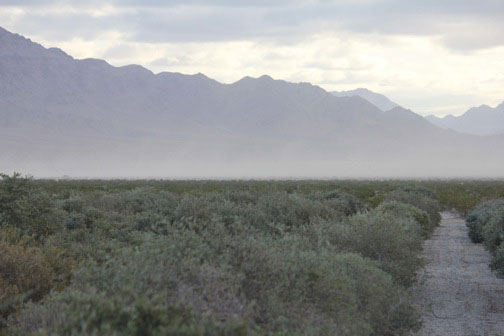
^Dust clouds from construction at Desert Sunlight Solar Farm choking the view of wilderness mountains in Joshua Tree National Park behind. (Photo by Larry and Donna Charpied)
December 6, 2011 - Construction is well underway at First Solar's Desert Sunlight project. Acres of beautiful desert have been scraped and graded by heavy machinery, and poles are now being placed into the ground to hold thousands of photovoltaic panels.
But residents have recorded violations of Air Quality mitigation measures. During grading and bulldozing vegetation, sensitive desert soils, and biological soil organisms that bind the dirt together, are ploughed up and leveled. This releases particulates into the air, which can be a concern for human health, viewscapes from nearby Joshua Tree National Park, as well as adding to the air pollution levels managed by the South Coast Air Quality Management District. First Solar is required to keep clouds of dust from forming by watering the graded bare dirt and new roads, as well as put soil palliatives down eventually.
These photos taken adjacent to the project site show gross violations of air quality compliance.
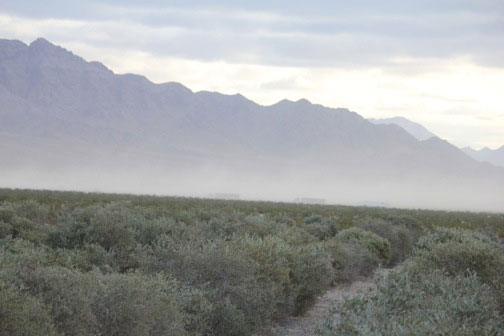
^Trucks on the Desert Sunlight project, clouds of dust obscuring the CoxComb Mountains. (Photo by Larry and Donna Charpied)
On December 8, 2011, reporter and environmental writer Chris Clarke photographed the new Desert Sunlight scars on the land during a plane flight. The living desert washes and ancient desert surfaces make natural patterns on Chuckwalla Valley, in contrast to the large blocks of scraped construction sites where the dust was raised.

^Extent of the earth disturbance on the Desert Sunlight solar project, and this is just the beginning. (Photo by Chris Clarke)
See more photos at:
http://www.kcet.org/updaily/the_back_forty/commentary/flying-to-the-solar-zone.html
Construction Begins
September 12, 2011 - Scraper-graders, a water truck, and a water tank can be seen in this photo taken a day ago from Kaiser Road adjacent to the massive photovoltaic power plant project. Biologists will be clearing tortoises off the desert project site during the window when temperatures are low enough to prevent stress on the reptiles.
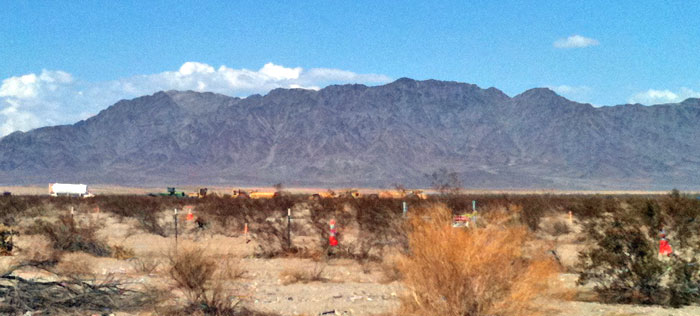
^Construction begins at Desert Sunlight Solar Farm. (Photo by Chris Clarke Copyright 2011)
See more photos of the beautiful Colorado Desert scenery on the project site taken from the access road on the west side, by Chris Clarke on his excellent blog Coyote Crossing.
Interior Approves Desert Sunlight
August 10, 2011 - Secretary of the Interior Ken Salazar today approved the Desert Sunlight Solar Farm, a 550-megawatt solar power project to be built in the California desert east of Palm Springs.
“The Desert Sunlight Solar Farm is the largest photovoltaic facility Interior has approved thus far and, when built, will help power our nation and economy,” Secretary Salazar said. “With 12 large-scale solar projects approved in the last 18 months, we continue to make significant strides in spurring innovation, job-creation, and investment in the private sector while strengthening America’s energy security.”
Located on approximately 4,100 acres of public lands, the solar project will be developed and operated by Desert Sunlight Holdings, LLC, a subsidiary of First Solar Inc. The facility will use First Solar’s thin film photovoltaic (PV) technology, which generates electricity with low visual impact, no air emissions, waste production or water use, and has the smallest carbon footprint of any PV technology. An on-site substation and a 230-kiloVolt (kV) generation tie line will connect the project to the Red Bluff substation which will convert the power from 230 kV to 500kV for transmission on Southern California Edison’s regional grid.
As part of Interior’s commitment to responsible development of renewable energy, the Desert Sunlight project underwent extensive environmental review and mitigation, with the final environmental impact statement issued on April 15, 2011. The Interior’s Bureau of Land Management (BLM) worked in close coordination with Desert Sunlight, the National Park Service and other stakeholders to significantly reduce the proposed project’s total footprint from 19,000 acres down to 4,144 acres. In addition, the BLM is requiring that Desert Sunlight provide funding for acquisition and enhancement of more than 7,500 acres of suitable habitat for desert tortoise and other sensitive wildlife species to help mitigate the project’s potential impacts.
“The BLM is committed to supporting a clean energy future for America by responsibly developing renewable energy on our country’s public lands,” BLM Director Bob Abbey said. “And part of that responsibility lies in mitigating the potential impacts of energy development on our wildlife and our lands."
In June, the U.S. Department of Energy granted Desert Sunlight a conditional commitment of a $1.88 billion loan guarantee. The project, about six miles north of the rural community of Desert Center, is expected to generate $336 million for the local economy from indirect benefits, including $197 million in wages. More than three quarters of the total impact will be occur during the construction period, with the remainder taking place over the project’s 25-year operating period. The project will also generate about $27 million in sales and property tax revenue to Riverside County.
Today’s decision authorizes the BLM to offer Desert Sunlight Holdings a right-of-way grant to use these public lands for 30 years if all rents and other conditions are met. The Record of Decision also approves amendments to the BLM’s California Desert Conservation Area Plan, identifying the Desert Sunlight Solar Farm site as available for solar energy development and identifying 14,500 acres in the Project Study Area as unavailable for solar energy development. The BLM oversees more than 1.5 million acres in Riverside County, including nearly a million acres managed for conservation.
$1.88 Billion DOE Loan Guarantee Granted
June 30, 2011 - U.S. Energy Secretary Steven Chu today announced offers of conditional commitments for loan guarantees, of approximately $4.5 billion, to support three alternating current Cadmium Telluride (Cd-Te) thin film photovoltaic (PV) solar generation facilities. The announcement includes $680 million for the Antelope Valley Solar Ranch in Los Angeles County, $1.88 billion for the Desert Sunlight project in Riverside County. and $1.93 billion in loans for the Topaz Solar project in Carrizo Plain, San Luis Obispo County.
This is an unprecedented subsidy to one company, First Solar, to support its Cadmium-Telluride thin-film photovoltaic panel projects. First Solar, Inc., with headquarters in Tempe, Arizona, is sponsoring all three projects and will provide Cd-Te thin film solar PV modules for the projects from a new manufacturing plant that has begun construction in Mesa, Arizona, as well as from its recently expanded manufacturing plant in Perrysburg, Ohio, which serves as its primary hub for engineering, research and development.
DOE is offering conditional commitments for partial loan guarantees to Desert Sunlight 250, LLC and Desert Sunlight 300, LLC to support the Desert Sunlight project. The 550 MW project is expected to generate 550 jobs during construction and will be located on land managed by the Bureau of Land Management in eastern Riverside County, California. The Desert Sunlight project is expected to use 8.8 million Cd-Te thin film solar PV modules, which are commercially proven and have been deployed since 2001. The facility is expected to generate enough electricity to power over 110,000 homes and will avoid over 735,000 metric tons of carbon dioxide annually. Project construction will take place in two phases; Phase I will generate 300MW of power, which will be sold to Pacific Gas & Electric Company, while Phase II will generate 250 MW of power, which will be sold to Southern California Edison. The $1.88 billion in loans that are partially guaranteed by DOE will be funded by a syndicate of institutional investors and commercial banks led by lead lender and lender-applicant, Goldman Sachs Lending Partners LLC, which submitted the project under the Financial Institution Partnership Program (FIPP), and Citibank N.A. as co-lead arranger.
http://www.energy.gov/news/10404.htm
Ask for an Extension on the Comment Deadline
May 10, 2011 - Bureau of Land Management's Final Environmental Impact Statement for this large solar project was released April 15, with a 30 day comment period, but we think 90 days is needed because of the size and complexity of the project. The comment period ends May 16. Below is from the Desert Sunlight FEIS:
"Emailed and faxed protests will not be accepted as valid protests unless the protesting party also provides the original letter by either regular or overnight mail postmarked by the close of the protest period. Under these conditions, the BLM will consider emailed or faxed protest as an advanced copy and will afford it full consideration. If you wish to provide BLM with such advance notification, please direct faxed protests to the attention of Brenda Hudgens-Williams - BLM Protest Expeditor at 202-912-7129, and emailed protests to Brenda_Hudgens-Williams@blm.gov."
Sample letter to send a request for an extension on the deadline for public comment to Mr. Jim Abbott, California BLM Director, at Jim_Abbott@blm.gov:
First Solar Desert Sunlight FEIS
Dear Mr. Abbott,
I request that the deadline for protests for the above captioned project be extended an additional 30 days.
The FEIS for this project is massive, and reading the cd is slow and tedious.
In the interest of the public, we urge you to extend the deadline to enable us to fully inform you, the decision-maker with all of the available information, thereby creating an environmentally sound project.
Thank you in advance for your consideration.
Respectfully Submitted,
Your Name
----------------------------------------------------------------------------------------------------
See http://www.blm.gov/ca/st/en/fo/palmsprings/Solar_Projects/Desert_Sunlight.html
General Description of Project
First Solar Development, Inc. (First Solar) proposes to construct and operate a 550-megawatt (MW) solar photovoltaic (PV) power plant project known as the Desert Sunlight Solar Farm (DSSF or Project). The DSSF would include three main components 1) the Solar Farm site, 2) a transmission line, and 3) a Southern California Edison (SCE) owned and operated substation, Red Bluff Substation.
The Solar Farm site is on land administered by the Bureau of Land Management (BLM) six miles north of the rural community of Desert Center, which is adjacent to the I-10 freeway in eastern Riverside County, California.
The Project includes a 230-kV transmission line that would extend south from the Solar Farm site and interconnect to the planned Red Bluff substation near I-10. The Red Bluff Substation would interconnect with the existing SCE Devers-Palo Verde 1 transmission line. The three main project components will require a total of about 4,410 acres – 4,090 acres for the Solar Farm, 230 acres for the transmission corridor, and 90 acres for the substation.
Tortoises, Desert, Private Property Values at Risk
April 16, 2011 - Desert Center, Riverside County, California.
The Final Environmental Impact Statement for First Solar's Desert Sunlight photovoltaic project in Chuckwalla Valley was released today by Bureau of Land Management. The public has 30 days and an extra thirty for IBLA on the plan amendment. Interior Secretary Ken Salazar will probably sign this Record of Decision. First Solar wants to try to start moving tortoises in September or even August 2011.
http://www.blm.gov/ca/st/en/fo/palmsprings/Solar_Projects/Desert_Sunlight.html
First Solar's stock dropped 2% at the release of the draft EIS:
http://www.tickerspy.com/newswire/?p=4341
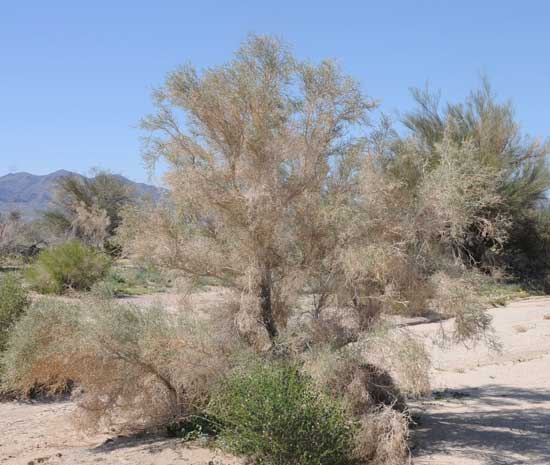
^Smoke tree and palo verde wash on the project site.
Desert Sunlight is Next to Joshua Tree National Park
[Federal Register: April 15, 2011 (Volume 76, Number 73)]
[Notices]
[Page 21402-21403]
From the Federal Register Online via GPO Access [wais.access.gpo.gov]
[DOCID:fr15ap11-81]
-----------------------------------------------------------------------
DEPARTMENT OF THE INTERIOR
Bureau of Land Management
[CACA 048649, LLCAD06000, L51010000.FX0000, LVRWB09B2490]
Notice of Availability of the Final Environmental Impact Statement for the Desert Sunlight Holdings, LLC, Desert Sunlight Solar Farm and Proposed California Desert Conservation Area Plan Amendment
AGENCY: Bureau of Land Management, Interior.
ACTION: Notice of Availability.
-----------------------------------------------------------------------
SUMMARY: In accordance with the National Environmental Policy Act of 1969, as amended (NEPA), and the Federal Land Policy and Management Act of 1976, as amended (FLPMA), the Bureau of Land Management (BLM) has prepared a Proposed California Desert Conservation Area (CDCA) Plan Amendment/Final Environmental Impact Statement (EIS) for the Desert Sunlight Solar Farm (DSSF) project and by this notice is announcing its
availability.
DATES: The BLM planning regulations state that any person who meets the conditions as described in the regulations may protest the BLM's Proposed CDCA Plan Amendment/Final EIS. A person who meets the conditions and files a protest must file the protest within 30 days of the date that the Environmental Protection Agency (EPA) publishes its
notice in the Federal Register. The protest procedures are described in the "Dear Reader'' letter accompanying the Proposed Plan Amendment/Final EIS.
ADDRESSES: Copies of the DSSF Proposed CDCA Plan Amendment/Final EIS have been sent to affected Federal, state, and local government agencies and to other stakeholders. Copies are available for public inspection at the Palms Springs South Coast Field Office, 1201 Bird Center Drive, Palm Springs, California 92262. Interested persons may also review the document at the following Web site: http://www.blm.gov/ca/st/en/fo/palmsprings/Solar_Projects/Desert_Sunlight.html. All
protests must be in writing and mailed to one of the following addresses:
Regular Mail: BLM Director (210), Attention: Brenda Williams, P.O. Box 71383, Washington, DC 20024-1383; Overnight Mail: BLM Director (210), Attention: Brenda Williams, 20 M Street, S.E., Room 2134LM, Washington, DC 20003.
FOR FURTHER INFORMATION CONTACT: For further information contact Allison Shaffer, BLM Project Manager, telephone (760) 833-7100; address (see above); or e-mail CAPSSolarFirstSolarDesertSunlight@blm.gov. Persons who use a telecommunications device for the deaf (TDD) may call the Federal Information Relay Service (FIRS) at 1-800-877-8339 to contact the above individual during normal business hours. The FIRS is
available 24 hours a day, 7 days a week, to leave a message or question with the above individual. You will receive a reply during normal business hours.
SUPPLEMENTARY INFORMATION: Desert Sunlight Holdings, LLC has submitted a right of way (ROW) application to the BLM to construct the proposed DSSF which includes a 550-megawatt (MW) solar photovoltaic (PV) facility and associated 220- kilovolt (kV) interconnection line (gen-tie line), and to facilitate the construction and operation by Southern California Edison (SCE) of the new 500/220-kV Red Bluff Substation, where the project would interconnect with the SCE regional transmission system. The total project footprint consists of approximately 4,165 acres of BLM-managed lands with a proposed ROW encompassing approximately 4,317 acres. The power generation site would consist of several components: A main generation area which includes PV arrays, combining switchgear, overhead lines, and access corridors; an operations and maintenance facility; a solar energy visitor center; an on-site substation; and site security and fencing. The gen-tie line ROW from the project to the proposed Red Bluff Substation would cover 256 acres with a 12-mile long, 160-foot wide corridor. The gen-tie line would transmit power to SCE's existing Devers-Palo Verde 1 (DPV1) 500-kV transmission line.
The Red Bluff Substation would consist of a 500/220-kV substation on approximately 76 acres, with an additional 73 acres for related features including access roads and drainage control. Substation features would include: connection of the project transmission line
into the substation; transmission lines to connect the substation to the DPV1 line; modification of DPV1 towers near the substation; construction of an electric distribution line for substation light and power; and installation of telecommunications facilities.
The project site is located approximately 6 miles north of Interstate 10 and the rural community of Desert Center in Riverside County. The project area is within 2 miles of Joshua Tree National Park.
The BLM's purpose and need for the DSSF project is to respond to an application for a ROW grant to construct, operate, maintain, and decommission a solar photovoltaic facility on public lands in compliance with FLPMA, BLM ROW regulations, and other applicable
Federal laws. The BLM will decide whether to approve, approve with modification, or deny the ROW for the proposed DSSF project. The BLM will also consider amending the CDCA Plan in this analysis. The CDCA Plan (1980, as amended), while recognizing the potential compatibility of solar generation facilities on public lands, requires that all sites
associated with power generation or transmission not identified in that plan be considered through the plan amendment process. If the BLM decides to grant a ROW, the BLM would also amend the CDCA Plan as required.
In the Final EIS, the proposed action is to authorize the DSSF project and approve a CDCA Plan amendment in response to the application received from Desert Sunlight Holdings, LLC. The BLM's preferred alternative is the proposed action, which consists of the power generation site (Solar Farm Layout B), Gen-Tie Line GT-A-1 (which parallels Kaiser Road), Substation A, and Access Road 2, aggregating 4,165 acres of permanent ground disturbance. Other alternatives to authorizing the proposed DSSF project include: (1) Authorize the Solar Farm Layout B, Gen-Tie Line GT-B-2, and Red Bluff Substation B,
aggregating 4,100 acres of permanent ground disturbance; and (2) authorize a reduced footprint alternative with a reduced output including Solar Farm Layout C (413 MW), Gen-Tie Line GT-A-2, Red Bluff Substation A, and Access Road 1, aggregating 3,292 acres of permanent ground disturbance. Additionally, the Final EIS analyzes two no project
alternatives: (1) Deny the project but amend the CDCA Plan to allow other solar energy power generation projects on the project site; and (2) deny the project and amend the CDCA Plan to prohibit solar energy projects on the project site. As required under NEPA, the Final EIS analyzes a no action alternative (no ROW grant and no CDCA Plan
amendment).
The Final EIS evaluates the potential impacts of the proposed DSSF and CDCA Plan Amendment on air quality, biological resources, cultural resources, water resources, geological resources and hazards, land use, noise, paleontological resources, public health, socioeconomics, soils, traffic and transportation, visual resources, wilderness
characteristics, and other resources. A Notice of Availability for the DSSF Draft CDCA Plan Amendment/Draft EIS was published by the EPA in the Federal Register on August
27, 2010 (75 FR 52736). The formal 90-day comment period ended on November 26, 2010. Comments were considered and incorporated as appropriate into the Proposed CDCA Plan Amendment/Final EIS. Public comments resulted in the addition of clarifying text, but did not significantly change proposed land use plan decisions.
Instructions for filing a protest with the Director of the BLM regarding the DSSF project may be found in the ``Dear Reader'' letter of the Proposed CDCA Plan Amendment/Final EIS and at 43 CFR 1610.5-2. E-mail and faxed protests will not be accepted as valid protests unless the protesting party also provides the original letter by either regular or overnight mail postmarked by the close of the protest period. Under these conditions, the BLM will consider the e-mail or faxed protest as an advance copy and it will receive full
consideration. If you wish to provide the BLM with such advance notification, please direct faxed protests to the attention of the BLM protest coordinator at 202-912-7212, and e-mails to Brenda_Hudgens-Williams@blm.gov. All protests, including the follow-up letter to e-mails or faxes, must be in writing and mailed to the appropriate address, as set forth in the ADDRESSES section above. Before including your phone number, e-mail address, or other personal identifying information in your protest, you should be aware that your entire protest-including your personal identifying information-may be made publicly available at any time. While you can ask us in your protest to withhold your personal identifying information from public review, we cannot guarantee that we will be able to do so.

^Phacelia blooming on the project site in Chuckwalla Valley. Joshua Tree National Park mountains lie in the distance.
HOME.....Desert Sunlight Spring 2010 Field Trip.....Chuckwalla Valley Updates
